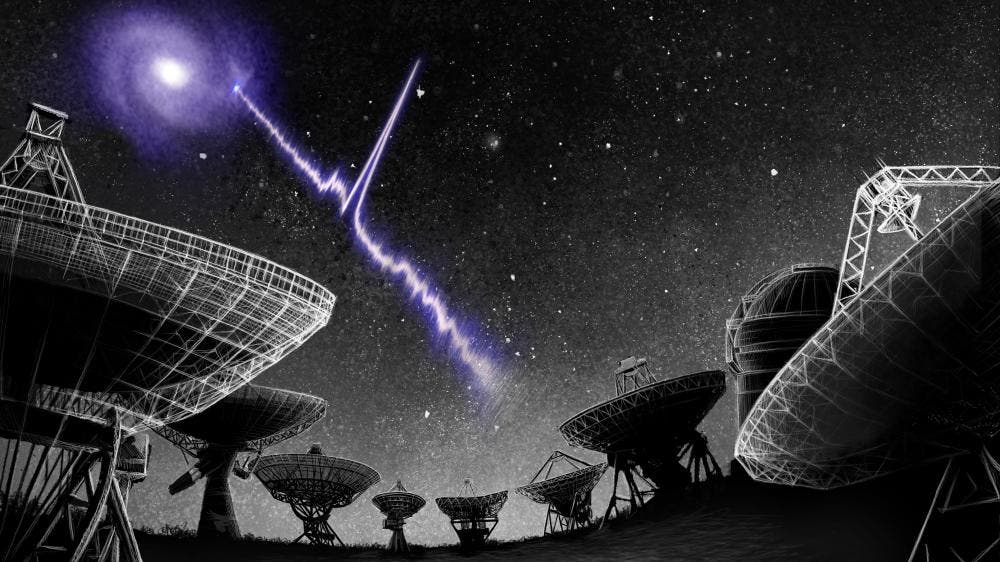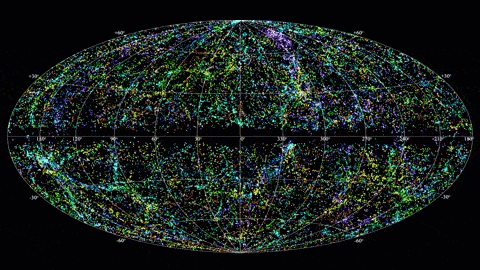
An international team of researchers used a whopping eight telescopes, part of the European Very Long Baseline Interferometry Network (EVN), to identify the source of a repeating fast radio burst (FRB) signal. The mysterious repeating signal comes from a spiral galaxy more than 500 million light-years away from Earth.
This is not only the closest repeating FRB we’ve found thus far, but its source is also unlike something astronomers have come across before.
“This blurs the differences between repeating and non-repeating fast radio bursts. It may be that FRBs are produced in a large zoo of locations across the Universe and just require some specific conditions to be visible,” Kenzie Nimmo, an astronomer at the University of Amsterdam and of the lead authors of the new study, said in a statement.
Blink and you’ll miss them
Fast radio bursts are among some of the weirdest astronomical phenomena. They only last for a few fractions of a second but in this short time, they pack more energy than 500 million Suns. They also exhibit the characteristic dispersion sweep of radio pulsars.
By one estimate, there are more than 2,000 of these FRBs firing across the Universe every day, but due to their short-lived nature detecting them is easier said than done.
First discovered in 2007, fast radio bursts continue to puzzle astronomers. Most of them have only appeared once but, to make things even more complicated, some of these signals appear repeatedly.

In 2017, scientists manage to track the source of a repeating FRB for the first time to a dwarf galaxy, located more than 3 billion light-years from Earth. This signal had been distorted by electromagnetic radiation that interacted with the FRB’s magnetic field, leading scientists to believe that the radio bursts were generated by an extreme event, perhaps in the vicinity of a supermassive black hole that typically occupies the heart of a galaxy. What’s more, the signal also bore telltale signs that it originated close to a star-forming region.
Now, a team of astronomers working with the Very Long Baseline Interferometry Network has found the source of a new repeating FRB, which was tracked to an inconspicuous-looking spiral galaxy called SDSS J015800.28+654253.0.
The newly found signal, called FRB 180916, was less distorted which must mean it comes from a region of space that is less disturbed by extreme objects like black holes, likely far away from a galactic center. But, like it predecessor, the bursts came from a region of that galaxy where star formation is prominent.
“With the characterisation of this source, the argument against pulsar-like emission as an origin for repeating FRBs is gaining strength”, says Ramesh Karuppusamy of the Max Planck Institute for Radio Astronomy (MPIfR), a co-author of the study. “We are at the verge of more such localisations brought about by the upcoming newer telescopes. These will finally allow us to establish the true nature of these sources,” he adds.

Astronomers hope to find more such FRBs so close to home in order to study these events in greater detail. In doing so, scientists might come closer to understanding the Universe itself. Why is that? One huge area of study in cosmology is how structures — any structure of any scale — were formed, and to answer such a big question, computational models have to make a lot of assumptions about the conditions of the early Universe. These theoretical results then have to be compared to physical observations of the actual cosmos. But if scientists can map thousands of FRBs from all directions, it is possible to map the distribution of matter across the universe because a FRB’s time delay indirectly offers an estimate of the amount of material between the source and Earth.
“We hope that continued studies will unveil the conditions that result in the production of these mysterious flashes. Our aim is to precisely localize more FRBs and, ultimately, understand their origin”, concludes Jason Hessels, corresponding author on the study, from the Netherlands Institute for Radio Astronomy (ASTRON) and the University of Amsterdam.
“As we continue to unravel the mystery of FRBs, astronomers need to be able to study these sources in incredible detail. The combined sensitivity of the telescopes in the EVN currently provides a unique opportunity to observe these events and we hope that continued observations will contribute to our understanding of these enigmatic sources.” says Francisco Colomer, Director of the Joint Institute for VLBI ERIC.
The findings were reported in the journals Nature and the Astrophysical Journal Letters.


